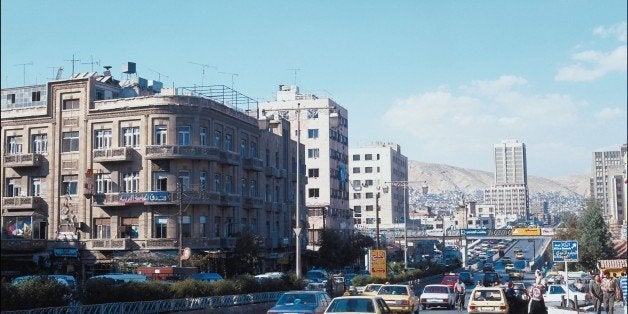
Twenty-seven US governors have recently closed their state's borders to Syrian refugees, including Michigan, Texas, and Alabama. Syrian Paranoia is in full-gear after at least one of the suspected Paris attackers was identified as a Syrian citizen who arrived in Europe via Greece last October, officially registered as a "Syrian Refugee." Since then panic has gripped world capitals by the throat especially those absorbing Syrian refugees arriving in "death boats" since 2011-2012. The one suspected suicide bomber might now destroy the future of thousands. It wasn't always like that; throughout their history, Syrian emigrants have played positive roles in their new homes; nation-builders rather than saboteurs. The suspected Paris criminal is an exception; he certainly is not the norm.
One thousand two hundred years ago, a young prince escaped from Damascus fleeing mayhem in his beloved city. Damascus was ablaze; its ruling clan the Umayyads had just been toppled and all his family members had been put to the sword. Abdul Rahman was only twenty when he and his four year old son became Syrian refugees. They threw themselves into the Euphrates River, swam against its current, and eventually found their way first to Palestine, then Morocco until reaching the shores of Europe, landing in Muslim Spain in September 755. One year later he established a powerful Islamic government in al-Andalus and has since been known by the name of Abdul Rahman al-Dakhel (The Entrant), or Abdul Rahman I.
Another Syrian refugee was Abdulfattah al-Jandali, a native of Homs in central Syria who went to the US in the 1950s and bore a child named Steve Jobs who revolutionized modern times with Apple Computers. Syrians still affectionately call him by his Syrian family name, "Steve Jandali." The inspirational story of such refugees is a strong reminder that all is not lost for the nine million Syrians who have fled their homes since war broke out in their country five years ago. According to the United Nations High Commissioner for Refugees, over three million of them have fled to neighboring countries and 100,000 have reached the shores of Europe. Many were not lucky as Abdul Rahman I--they died in the waters of the Mediterranean. Aylan Kurdi, a toddler, was one of them. He washed up on the shores of Turkey last September, wearing a red shirt and blue shorts, gripping the hearts of millions on all four corners of the world.
Emigration and refugee success stories are not new to Syria. Damascus itself has always been a city of refugees, inhabited by Arabs, Turks, Armenians, Kurds, North Africans, and Circassians fleeing violence in their respective countries. Some came searching for sanctuary, others for good education and jobs. Some were attracted to its pleasant weather; others to its economic opportunities and the religious Sufi experience it offered. Syria's first post-Ottoman ruler, Emir Said El Djazairi, was the grandson of an Algerian emigrant, after all. So was Abdul Rahman Khleifawi, a two-time prime minister of the 1970s, while Syria's longest serving parliament speaker, Abdul Qader Qaddura, was the son of a Libyan refugee in Damascus. Until present, there are neighborhoods in the old city called "Hindi, Sudani, Maghribi" after Indian, Sudanese, and Moroccan residents.
Syrians have been there before, in different times with different players. This is the sixth wave of mass immigration during the past 100-years. It's the largest, no doubt, and the one to receive most media attention. The first was during the Great War, back in 1914. Syrians were forcefully conscripted into the Ottoman Army and sent to the faraway battlefronts of Europe. Some returned to tell the tale; while thousands perished in combat. Of the 2.8 million Arabs sent to fight, 325,000 died in 1914-1918. Another 240,000 died of disease, while no less than 250,000 were listed as "missing" or "Prisoners of War." Fifty percent of them were Syrians.
To avoid war, Syrian refugees found sanctuary in North and South America. They created a vibrant Syrian community melting well with American society. An earlier generation had already settled in the US back in the 1880s, namely in New York and Boston. They nudged their relatives to take the long and hard journey: "Come to America." Approximately 90,000 Syrians arrived in the United States between 1899 and 1919. The first generation Syrian-Americans never returned to live in Syria. The most famous of them was the renowned poet Gibran Khalil Gibran who landed in America in 1895.
When the French invaded Syria in 1920, thousands fled once again, this time to British-occupied Palestine and Egypt. Cairo had its rich cultural life and cosmopolitan society, opening its arms wide for Syrian refugees. The Syrian community opened shops, restaurants and newspapers, and so influential did they become that King Ahmad Fouad II created a special seat for them in the Egyptian Parliament, reserved exclusively for Shawam (as all Syrian émigrés were called).
A third emigration wave started in 1925 when a military uprising broke out against French rule in Syria. Entire villages were stormed by the French and the capital itself was bombed from the skies, resulting in thousands of innocent deaths and the exodus of 25,000 citizens. Entire families packed up and headed for safer Arab cities like Cairo, Baghdad, and Beirut. None of them stayed on this time--they all returned when the guns went silent in 1927. A fourth wave of Syrian emigration started in 1960. This time it was an elitist one composed of bankers, landowners, industrialists, and powerful businessmen who fled the socialist dragnet of the Syrian-Egyptian Union regime. They set up banks, worked in the oil business, and their middle class professionals quickly found jobs as university and high school teachers, engineers, and doctors. Most of them never returned to Syria. The fifth wave was during the bloody confrontation between the Syria Government and the Muslim Brotherhood in the early 1980s.
The sixth wave is that of today, of 2011-2015. Nobody knows if it will be the last, but judging by the pace of modern history, others are yet to come, especially if the vicious Syrian War does not end soon. The refugees of today are still adapting to their new lives, topped with culture shock, poverty, and the scars of war. All of them are driven by economic need and safety concerns. Many will become a financial burden and headache--no doubt--but others might change the face of history, just like Abdul Rahman I did to Spain and Steve Jobs did to America.
